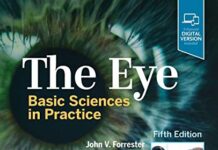
Ebook Info
- Published:
- Number of pages:
- Format: PDF
- File Size: 71.54 MB
- Authors: John V. Forrester MBChB MD FRCS(Ed) FRCP(Glasg)
Description
The Eye: Basic Sciences in Practice provides highly accessible, concise coverage of all the essential basic science required by today’s ophthalmologists and optometrists in training. It is also essential reading for those embarking on a career in visual and ophthalmic science, as well as an invaluable, current refresher for the range of practitioners working in this area. This new fourth edition has now been fully revised and updated in line with current curricula, key research developments and clinical best practice. It succinctly incorporates the massive strides being made by genetics and functional genomics based on the Human Genome Project, the new understanding of how the microbiome affects all aspects of immunology, the remarkable progress in imaging technology now applied to anatomy and neurophysiology, as well as exciting new molecular and other diagnostic methodologies now being used in microbiology and pathology. All this and more collectively brings a wealth of new knowledge to students and practitioners in the fields of ophthalmology and visual science. For the first time, this (print) edition also now comes with bonus access to the complete, fully searchable electronic text – including carefully selected additional information and new video content to further explain and expand on key concepts – making The Eye a more flexible, comprehensive and engaging learning package than ever before. The only all-embracing textbook of basic science suitable for trainee ophthalmologists, optometrists and vision scientists – other books concentrate on the individual areas such as anatomy.Attractive page design with clear, colour diagrams and text boxes make this a much more accessible book to learn from than many postgraduate textbooks.Presents in a readable form an account of all the basic sciences necessary for an understanding of the eye – anatomy, embryology, genetics, biochemistry, physiology, pharmacology, immunology, microbiology and infection and pathology.More on molecular pathology.Thorough updating of the sections on pathology, immunology, pharmacology and immunology.Revision of all other chapters.More colour illustrationsComes with complete electronic version
Reviews
Reviews from Amazon users which were colected at the time this book was published on the website:
⭐In depth information and easy to understand
⭐Excellent basic for all oophrhalmologidts
⭐Excellent review on basics sciences in relation to ophthalmology. One of my preferred references.
⭐Very good text for basic eye sciences
⭐Very thorough. Definite must have.
⭐as described
⭐Currently studying from it, I love it.
⭐Wer sich dem ICO-Examen im Bereich der “Basic Sciences” stellen möchte, muss sich zu Beginn der Lernperiode überlegen, welches dieser umfangreichen Lehrbücher er oder sie sich zulegen möchte und leider ist die Auswahl nicht sehr groß.”The Eye” beginnt mit einem zunächst recht verständlich formuliertem Kapitel zur Anatomie des Auges (+ Orbita, etc.), welches sich aufgrund der noch vorhandenen Anatomiekenntnisse aus dem Studium recht gut lesen lässt. Auch das Kapitel über Embryologie und Genetik des Auges sind gut geschrieben. Leider sinkt die Qualität des Buches im weiteren Verlauf sehr stark, was sehr enttäuschend ist. Im Folgenden die Details:Für mich ist das zentrale Problem an diesem Buch, das es dort, wo es darauf ankommt, nicht den didaktischen Anforderungen eines Lehrbuchs entspricht. Soll heißen: Es ist durchgehend auf eine Weise geschrieben, die ein extensives Grundwissen voraussetzt, welches Assistenzärzte der Augenheilkunde ganz einfach nicht haben können, dabei sollen diese Grundkenntnisse doch vermittelt werden, wie es scheint. Meines Erachtens liegt dies auch daran, dass die Autoren sich ständig in Details verzetteln und die Selektion der wirklich wichtigen Informationen auf der Strecke bleibt. Nach den meisten Absätzen bleibt die Frage offen, was denn nun wirklich relevant war von dem, was man da gerade gelesen hat. Hinzu kommt, dass viele Kapitel sehr sprunghaft geschrieben sind und der rote Faden fehlt. Fakten werden aneinander gereiht, deren innerer Zusammenhang oftmals nicht ersichtlich ist.Weitere Probleme, kurz gefasst:1. In zentralen Punkten werden inhaltliche Fehler gemacht bzw. treten Widersprüche zwischen den von unterschiedlichen Autoren geschrieben Kapiteln auf. Wikipedia musste mehrfach für Klarheit sorgen.2. Man merkt deutlich, wenn unterschiedliche Autoren am Werk waren, weil sich manche Inhalte sehr häufig wiederholen. Der Eindruck wird erweckt, dass schlampig korrekturgelesen wurde.3. Viele Grafiken, insbesondere in den Kapiteln Biochemie und Physiologie, sind entweder völlig irrelevant (z.B. seitenweise unkommentierter Abbildung der Tertiärstruktur von retinalen Proteinen) oder, und das ist noch viel ärgerlicher, werden nicht ausreichend durch eine Legende beschrieben. An vielen Stellen tauchen Abkürzungen in Abbildungen auf, die in der Legende nicht definiert werden. So werden ganze Abbildungen unbrauchbar.Fazit:Zwar sind die ersten drei Kapitel in Ordnung, insgesamt muss von diesem unselektiv und teils schlampig geschriebenen Buch aber unbedingt abgeraten werden.
⭐Good book
⭐Great book
⭐Its a good book. Easy to go through it.
Free Download
